Yesterday’s main Elliott wave count expected upwards movement to continue. The target remains the same.
Summary: At this stage, it is possible that minor wave 3 could be over. Confidence in this view is required with a new low below 3,244.91.
If price continues higher, then the next target would be at 3,289.
Three large pullbacks or consolidations (fourth waves) during the next 1-2 years are expected: for minor wave 4 (coming soon, possibly just begun), then intermediate (4), and then primary 4. Extreme conditions warrant more careful attention to risk management at this time.
The biggest picture, Grand Super Cycle analysis, is here.
Monthly charts were last published here, with video here. There are two further alternate monthly charts here, with video here.
ELLIOTT WAVE COUNTS
The two weekly Elliott wave counts below will be labelled First and Second. They may be about of even probability. When the fifth wave currently unfolding on weekly charts may be complete, then these two wave counts will diverge on the severity of the expected following bear market. To see an illustration of this future divergence monthly charts should be viewed.
FIRST WAVE COUNT
WEEKLY CHART
The basic Elliott wave structure consists of a five wave structure up followed by a three wave structure down (for a bull market). This wave count sees the bull market beginning in March 2009 as an incomplete five wave impulse and now within the last fifth wave, which is labelled cycle wave V. This impulse is best viewed on monthly charts. The weekly chart focusses on the end of it.
Elliott wave is fractal. This fifth wave labelled cycle wave V may end a larger fifth wave labelled Super Cycle wave (V), which may end a larger first wave labelled Grand Super Cycle wave I.
The teal Elliott channel is drawn using Elliott’s first technique about the impulse of Super Cycle wave (V). Draw the first trend line from the end of cycle wave I (off to the left of the chart, the weekly candlestick beginning 30th November 2014) to the end of cycle wave III, then place a parallel copy on the end of cycle wave II (off to the left of the chart, the weekly candlestick beginning 14th February 2016). This channel perfectly shows where cycle wave IV ended at support. The strongest portion of cycle wave III, the end of primary wave 3, overshoots the upper edge of the channel. This is a typical look for a third wave and suggests the channel is drawn correctly and the way the impulse is counted is correct.
Within Super Cycle wave (V), cycle wave III is shorter than cycle wave I. A core Elliott wave rule states that a third wave may never be the shortest. For this rule to be met in this instance, cycle wave V may not be longer in length than cycle wave III. This limit is at 3,477.39.
Cycle wave V may subdivide either as an impulse or an ending diagonal. Impulses are much more common, and it is clear at this stage that cycle wave V is an impulse and not a diagonal.
At this stage, cycle wave V may take another one to two or so years to complete.
The daily chart below will focus on movement from the end of intermediate wave (2) within primary wave 3.
In historic analysis, two further monthly charts have been published that do not have a limit to upwards movement and are more bullish than this wave count. Members are encouraged to consider those possibilities (links below summary) alongside the wave counts presented on a daily and weekly basis. It is my judgement that the two weekly wave counts published in this analysis have the highest probability, so they shall be the only wave counts published on a daily basis.
Within cycle wave V, primary waves 1 and 2 may be complete. Within primary wave 3, intermediate waves (1) and (2) may be complete. Within the middle of intermediate wave (3), minor wave 4 may not move into minor wave 1 price territory below 3,021.99.
DAILY CHART
All of primary wave 3, intermediate wave (3) and minor wave 3 may only subdivide as impulses.
Minor wave 3 has passed 1.618 the length of minor wave 1, and within it minute wave v has passed equality in length with minute wave i. The next target may be now about 3,289 where minuette wave (v) within minute wave v would reach 1.618 the length of minuette wave (i).
Minor wave 2 was a sharp deep pullback, so minor wave 4 may be expected to be a very shallow sideways consolidation to exhibit alternation. Minor wave 2 lasted 2 weeks. Minor wave 4 may be about the same duration, or it may be a longer lasting consolidation. Minor wave 4 may end within the price territory of the fourth wave of one lesser degree; minute wave iv has its range from 3,154.26 to 3,070.49.
Minor wave 4 may not move into minor wave 1 price territory below 3,021.99.
Intermediate wave (3) has now moved far enough above the end of intermediate wave (1) to allow intermediate wave (4) to unfold and remain above intermediate wave (1) price territory.
Draw an acceleration channel now about intermediate wave (3): draw the first trend line from the end of minor wave 1 to the last high, then place a parallel copy on the end of minor wave 2. Keep redrawing the channel as price makes new highs. Minor wave 4 may find support at the lower edge of this channel if it is long lasting or deep enough.
Price is approaching the upper edge of the wide teal channel copied over from monthly and weekly charts. If price gets up to this trend line, then a reaction downwards there would be highly likely.
HOURLY CHART
It is possible that minor wave 3 may be close to completion.
Within minuette wave (v), subminuette waves i and ii may be complete. Subminuette wave iii may only subdivide as an impulse. Within subminuette wave iii, micro wave 3 may be incomplete. Within micro wave 3, sub-micro wave (4) may not move into sub-micro wave (1) price territory below 3,244.91.
ALTERNATE HOURLY CHART
If price breaks below 3,244.91, then assume minor wave 4 has arrived.
A correction to last about two weeks should begin with a five down on the hourly chart. Within that first five down, no second wave correction may move beyond the start of its first wave above 3,267.07.
Minor wave 4 may end within the price territory of the fourth wave of one lesser degree. Minute wave iv has its range from 3,154.26 to 3,070.49.
Minor wave 4 may end at a Fibonacci ratio of minor wave 3. Fibonacci areas of support are the 0.146 Fibonacci ratio at 3,207.05, the 0.236 Fibonacci ratio at 3,170.05, the 0.382 Fibonacci ratio at 3,110.03, and the 0.618 Fibonacci ratio at 3,013.00. Only the 0.302 Fibonacci ratio at 3,110.03 sits within the range of minute wave iv, so this Fibonacci ratio is favoured as a target for minor wave 4.
SECOND WAVE COUNT
WEEKLY CHART
This weekly chart is almost identical to the first weekly chart, with the sole exception being the degree of labelling.
This weekly chart moves the degree of labelling for the impulse beginning in March 2009 all down one degree. This difference is best viewed on monthly charts.
The impulse is still viewed as nearing an end; a fifth wave is still seen as needing to complete higher. This wave count labels it primary wave 5. Primary wave 5 may still need another year to two or so to complete, depending upon how time consuming the corrections within it may be.
Primary wave 5 may be subdividing as an impulse, in the same way that cycle wave V is seen for the first weekly chart.
TECHNICAL ANALYSIS
MONTHLY CHART
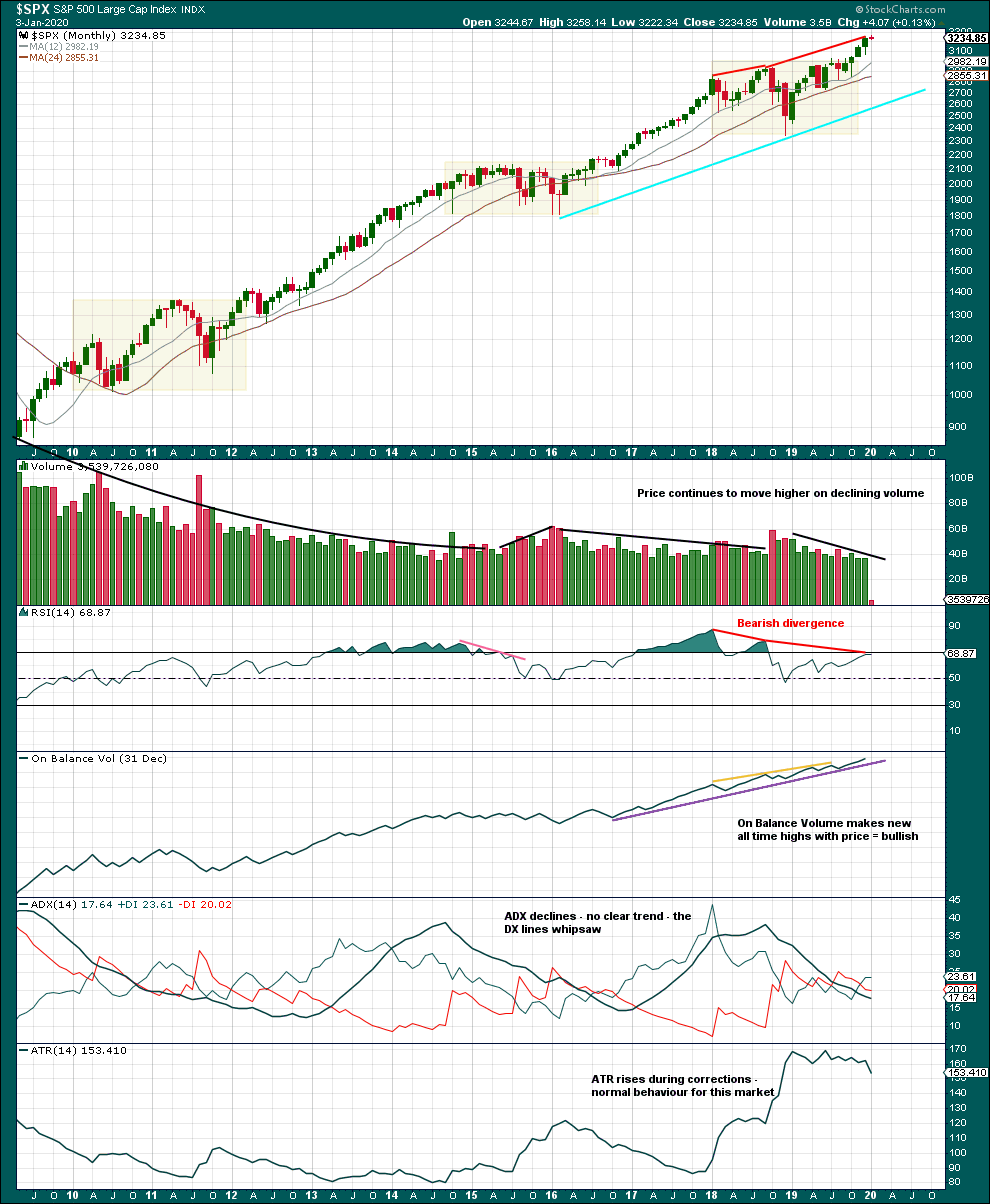
Click chart to enlarge. Chart courtesy of StockCharts.com.
There are three large consolidations noted on this chart, in shaded areas. After a breakout from a multi-month consolidation, it is reasonable to expect a multi month bullish move may result.
Note that in each of the first two cases a pullback saw price re-enter the consolidation zone after the breakout, before price then moved up and away. It is possible that may happen again after the last breakout from a consolidation.
This chart very clearly exhibits rising price on declining volume has now persisted for several years. A decline in volume last month, in current market conditions, is not of concern.
On Balance Volume supports the Elliott wave count.
WEEKLY CHART
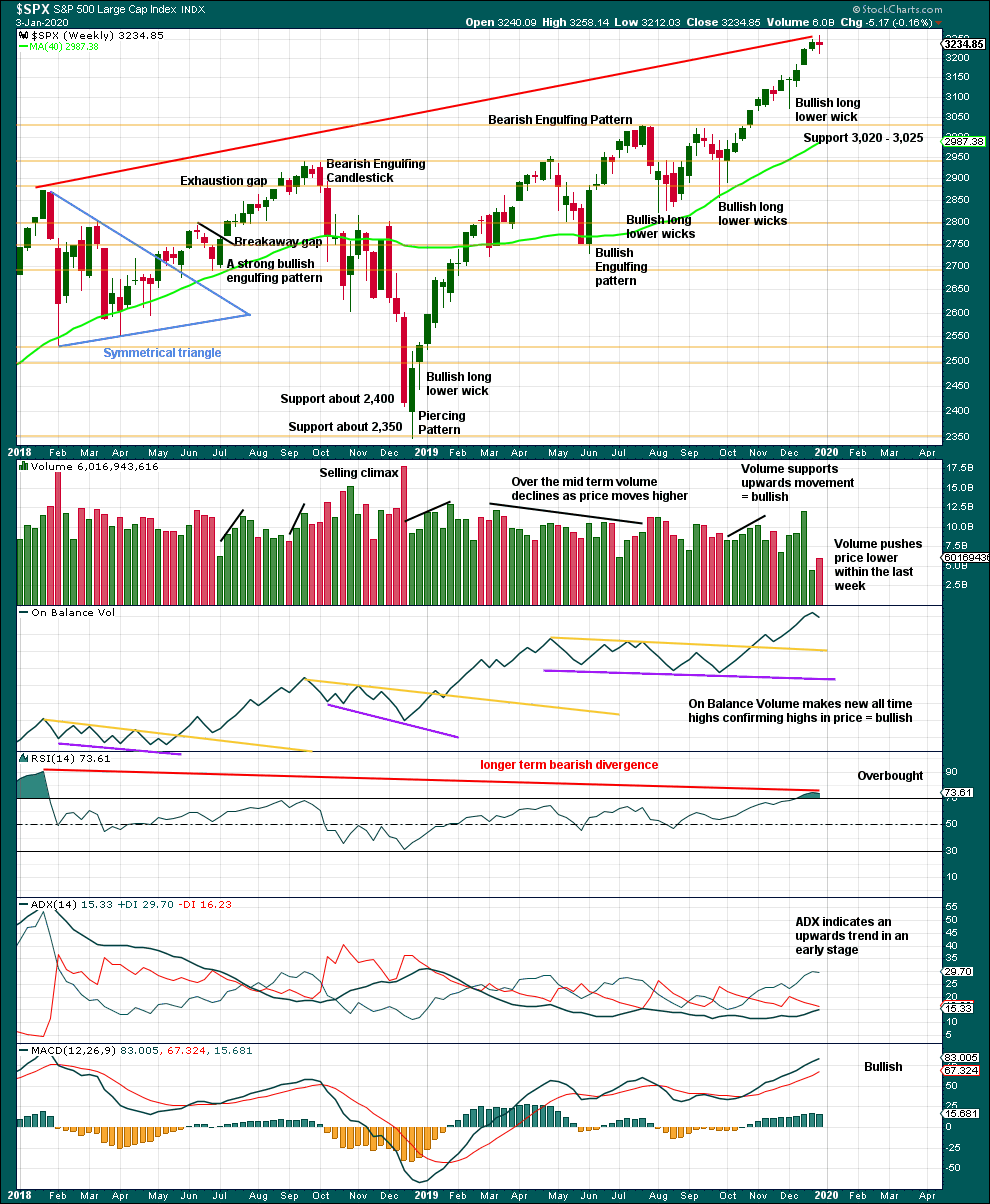
Click chart to enlarge. Chart courtesy of StockCharts.com.
It is very clear that the S&P is in an upwards trend and the bull market is continuing. Price does not move in straight lines; there will be pullbacks and consolidations along the way.
This chart is overall bullish. There are no signs of weakness in upwards movement.
RSI is now overbought. That does not mean upwards movement must end here, because it can continue for several weeks while RSI reaches more extreme. RSI reaching overbought is a warning that conditions are now becoming extreme. A pullback or consolidation will follow and the longer conditions are extreme the closer this will be. However, assume the trend remains the same until proven otherwise. This warning should be heeded by careful attention to risk management.
The doji last week on its own is not a reversal signal. It is a sign of a small pause.
DAILY CHART
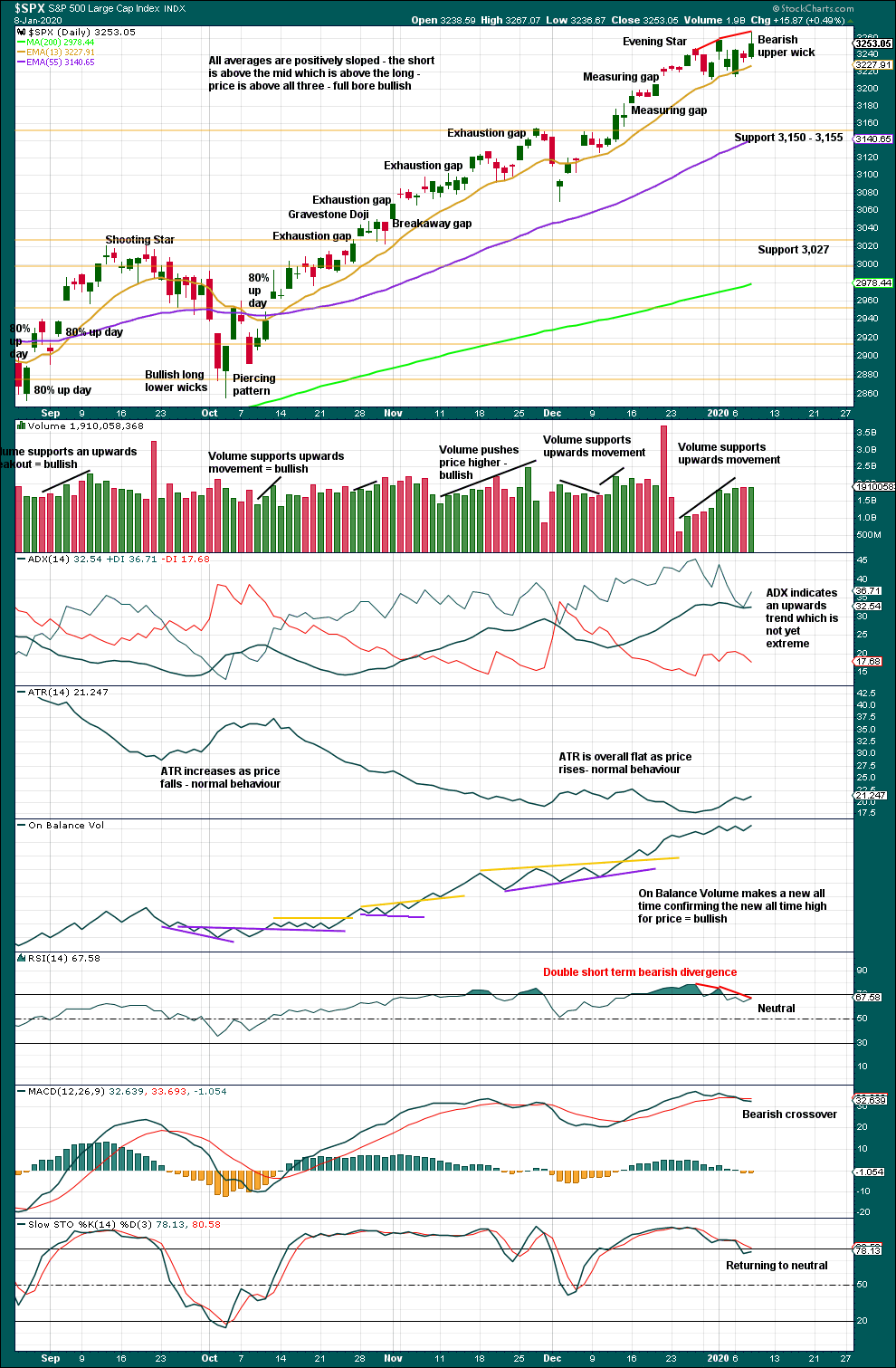
Click chart to enlarge. Chart courtesy of StockCharts.com.
There is an upwards trend in place. There will be corrections along the way.
Like the weekly chart, this chart is bullish.
RSI now exhibits double bearish divergence while overbought. This is often (not always) a warning of a pullback or consolidation to develop. Today the warning is stronger.
BREADTH – AD LINE
WEEKLY CHART
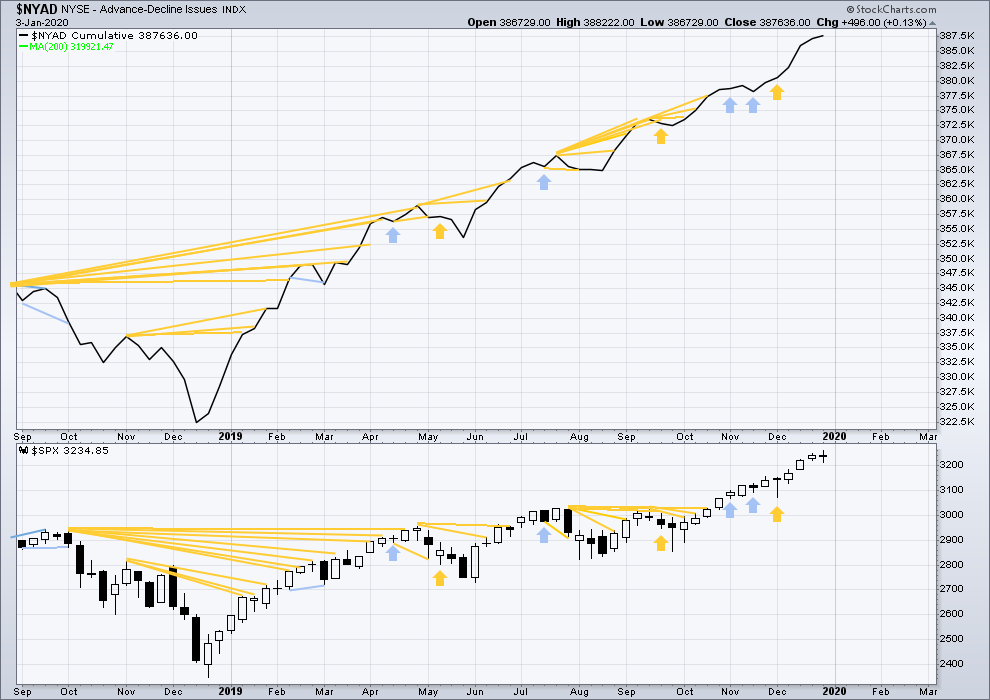
Click chart to enlarge. Chart courtesy of StockCharts.com. So that colour blind members are included, bearish signals
will be noted with blue and bullish signals with yellow.
Bear markets from the Great Depression and onwards have been preceded by an average minimum of 4 months divergence between price and the AD line with only two exceptions in 1946 and 1976. With the AD line making new all time highs this week, the end of this bull market and the start of a new bear market is very likely a minimum of 4 months away, which is the beginning of May 2020.
In all bear markets in the last 90 years there is some positive correlation (0.6022) between the length of bearish divergence and the depth of the following bear market. No to little divergence is correlated with more shallow bear markets. Longer divergence is correlated with deeper bear markets.
If a bear market does develop here, it comes after no bearish divergence. It would therefore more likely be shallow.
All of small, mid and large caps have made new swing highs above the prior swing high on the 13th of September, and mid caps have now made new all time highs. This upwards movement appears to be mostly driven by large caps, which is a feature of aged bull markets. This bull market at over 10 years duration certainly fits the definition of aged.
Again both price and the AD line have made new all time highs. There is no divergence. Upwards movement has support from rising market breadth.
Large caps all time high: 3,267.07 on 8th January 2020.
Mid caps all time high: 2,073.72 on 2nd January 2020.
Small caps all time high: 1,100.58 on 27th August 2018.
DAILY CHART
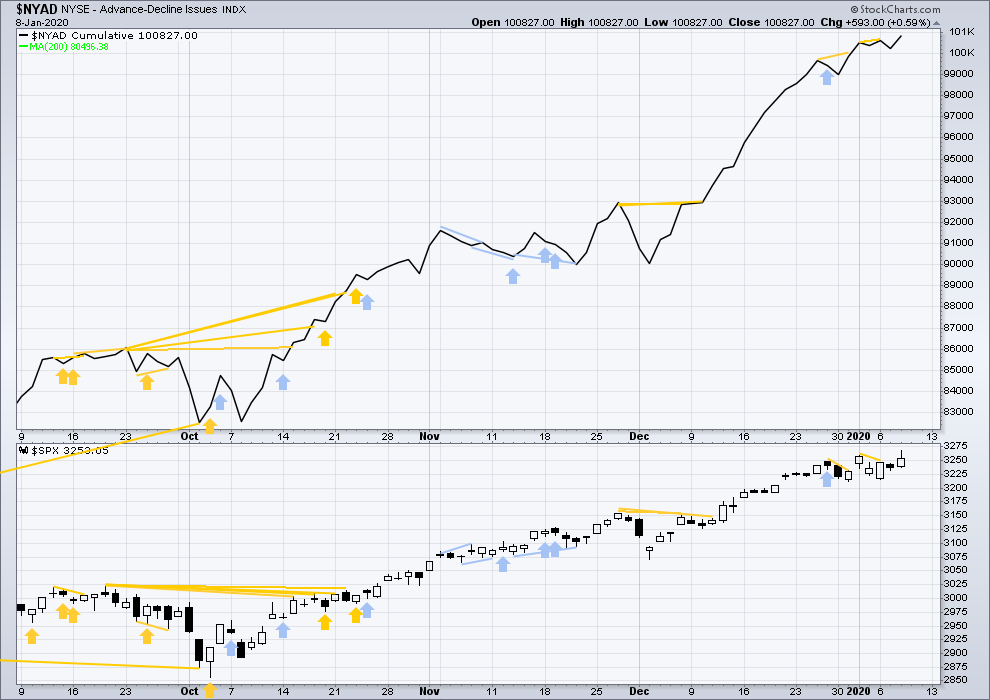
Click chart to enlarge. Chart courtesy of StockCharts.com. So that colour blind members are included, bearish signals
will be noted with blue and bullish signals with yellow.
Breadth should be read as a leading indicator.
Today both price and the AD line have made new all time highs. There is no new divergence.
VOLATILITY – INVERTED VIX CHART
WEEKLY CHART
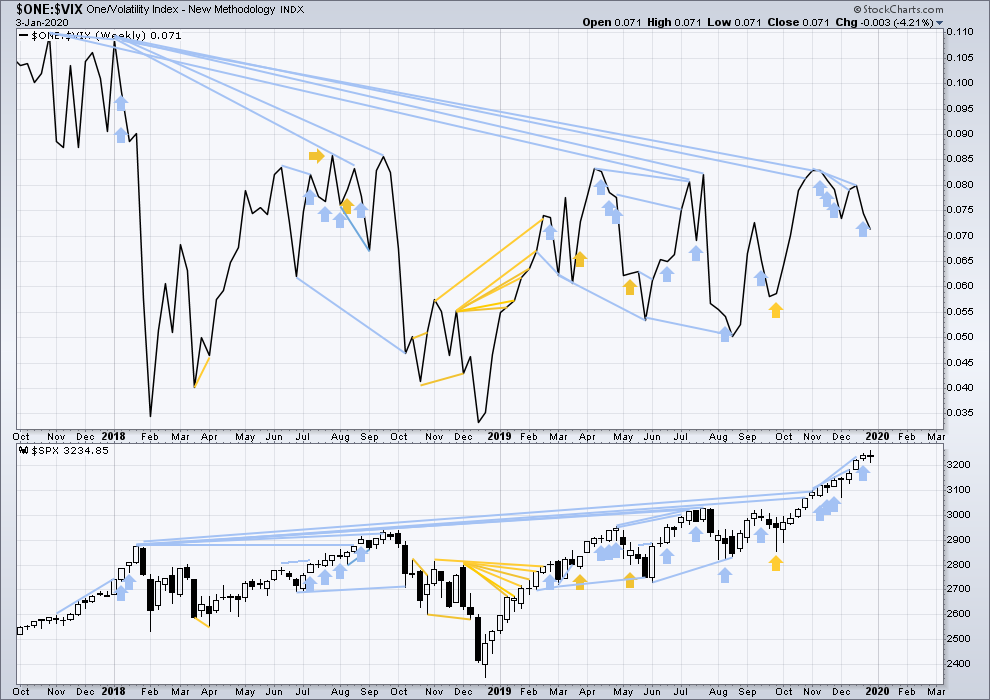
Click chart to enlarge. Chart courtesy of StockCharts.com. So that colour blind members are included, bearish signals
will be noted with blue and bullish signals with yellow.
The all time high for inverted VIX was on 30th October 2017. There is now over two years of bearish divergence between price and inverted VIX.
The rise in price is not coming with a normal corresponding decline in VIX; VIX remains elevated. This long-term divergence is bearish and may yet develop further as the bull market matures.
This divergence may be an early warning, a part of the process of a top developing that may take years. It may is clearly not useful in timing a trend change from bull to a fully fledged bear market.
Last week completes an outside week. Inverted VIX has declined during the week. There is no new short-term divergence.
DAILY CHART

Click chart to enlarge. Chart courtesy of StockCharts.com. So that colour blind members are included, bearish signals
will be noted with blue and bullish signals with yellow.
Today both price and inverted VIX have moved higher. Price has made new highs, but there remains all of short, mid and long-term bearish divergence as inverted VIX has not made corresponding highs.
DOW THEORY
Dow Theory confirmed a bear market in December 2018. This does not necessarily mean a bear market at Grand Super Cycle degree though; Dow Theory makes no comment on Elliott wave counts. On the 25th of August 2015 Dow Theory also confirmed a bear market. The Elliott wave count sees that as part of cycle wave II. After Dow Theory confirmation of a bear market in August 2015, price went on to make new all time highs and the bull market continued.
DJIA: 23,344.52 – a close on the 19th of December at 23,284.97 confirms a bear market.
DJT: 9,806.79 – price has closed below this point on the 13th of December.
S&P500: 2,532.69 – a close on the 19th of December at 2,506.96 provides support to a bear market conclusion.
Nasdaq: 6,630.67 – a close on the 19th of December at 6,618.86 provides support to a bear market conclusion.
With all the indices having moved higher following a Dow Theory bear market confirmation, Dow Theory would confirm a bull market if the following highs are made:
DJIA: 26,951.81 – a close above this point has been made on the 3rd of July 2019.
DJT: 11,623.58 – to date DJT has failed to confirm an ongoing bull market.
S&P500: 2,940.91 – a close above this point was made on the 29th of April 2019.
Nasdaq: 8,133.30 – a close above this point was made on the 26th of April 2019.
Published @ 06:35 p.m. EST.
—
Careful risk management protects your trading account(s).
Follow my two Golden Rules:
1. Always trade with stops.
2. Risk only 1-5% of equity on any one trade.
—
New updates to this analysis are in bold.


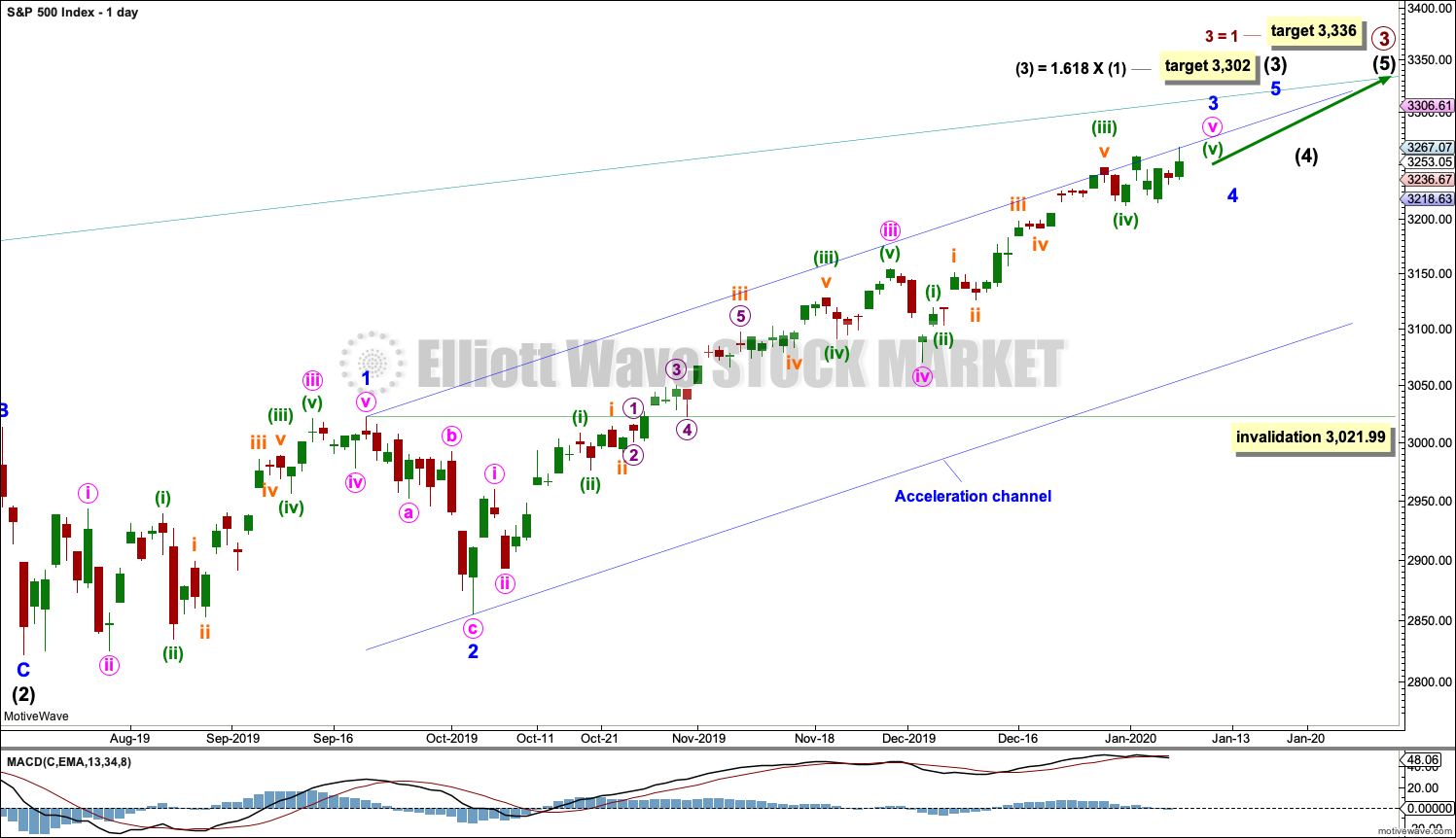

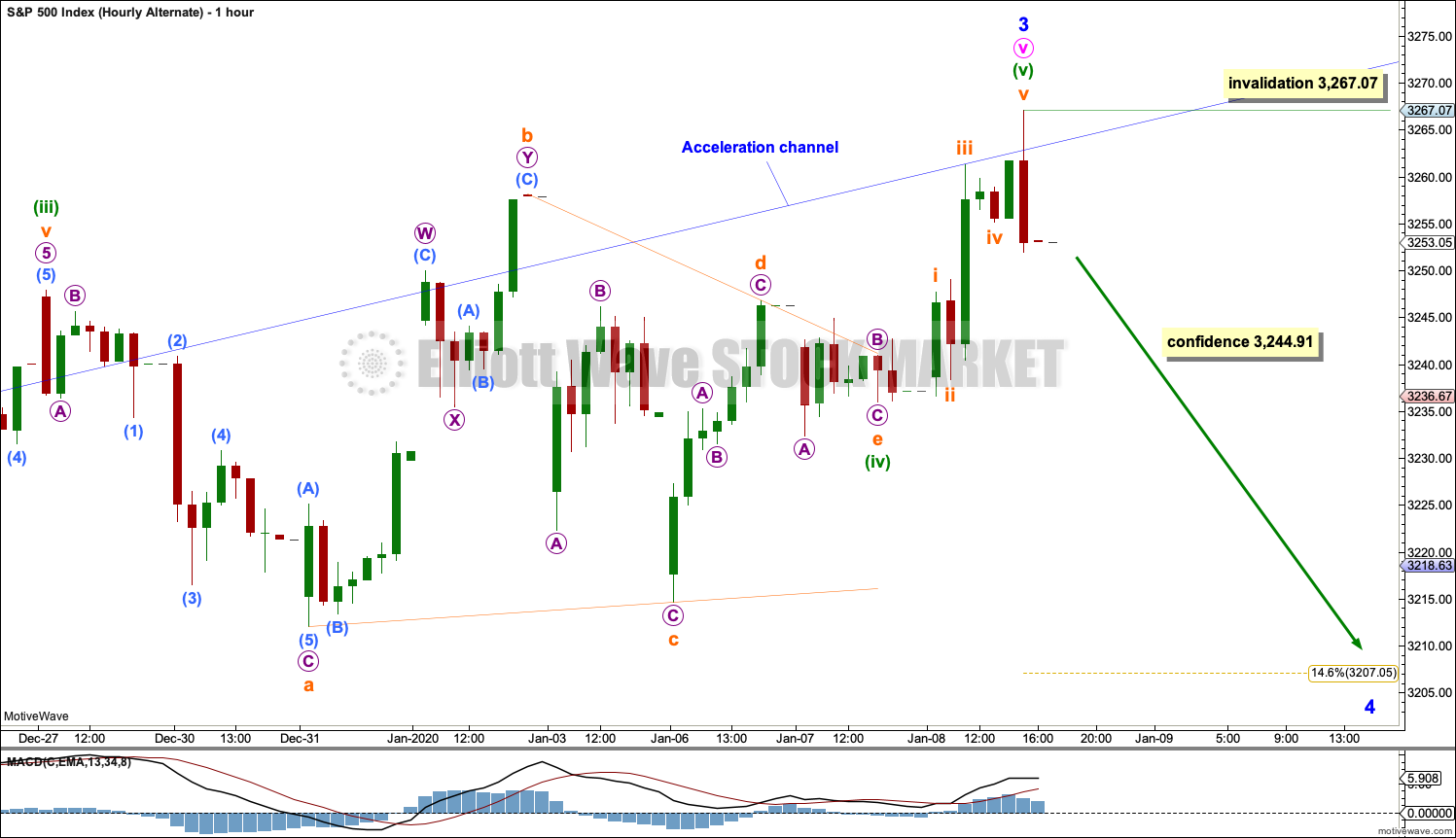
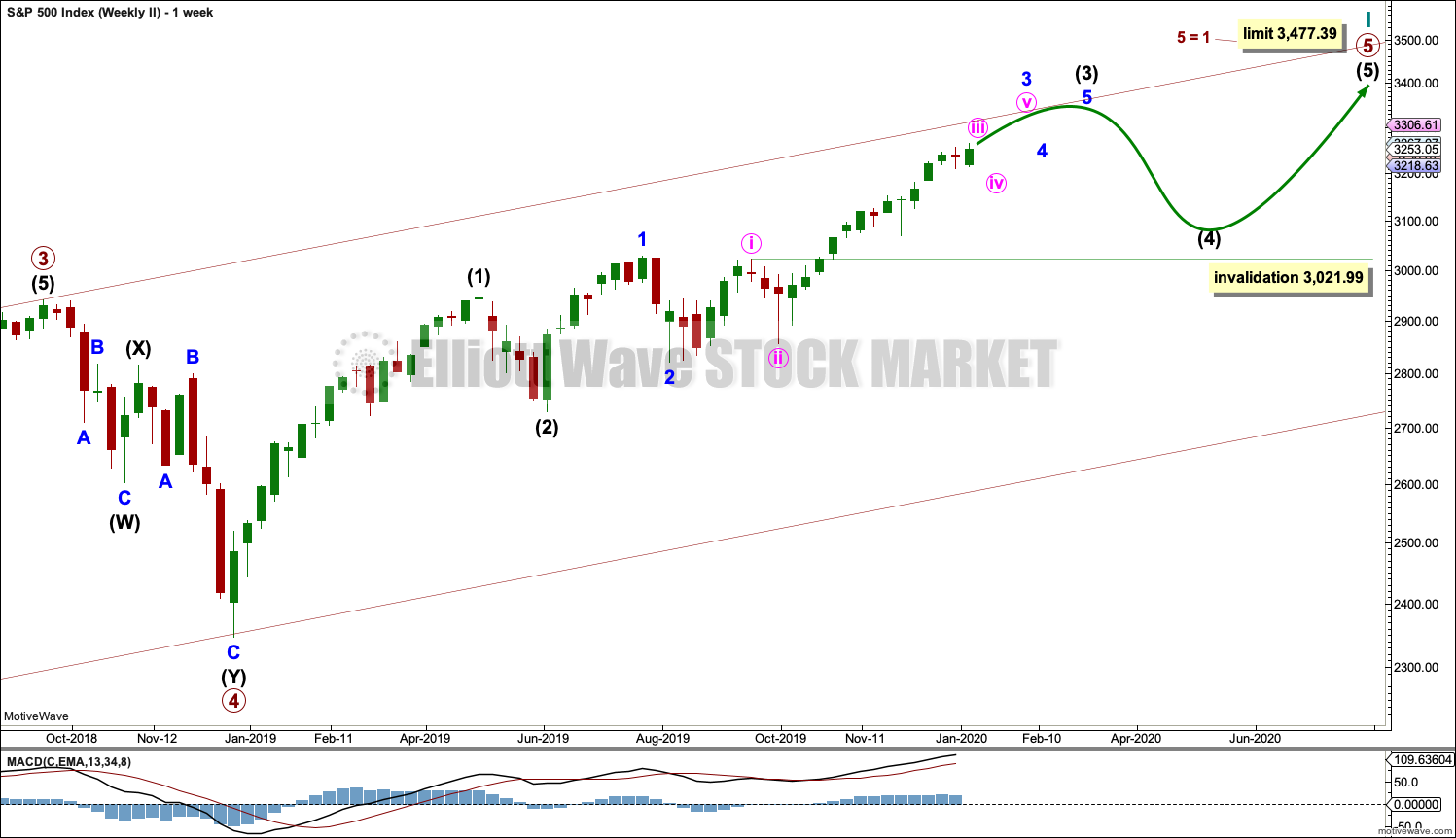
3276 has been a Fibonacci extension target for me for the minute v wave for some time. Multiple tags and general stalling under it today. While it’s “okay” for the larger minor 3, 3296 is quite a bit better, and is consistent with Lara’s up to hour hour assessment below.
Hourly chart update:
Minor 3 could be over in one to two more sessions possibly. Now requiring micro wave 5 upwards to complete subminuette iii as an impulse, then subminuette iv to be a small intra day correction, and then a final fifth wave up for subminuette v to complete the whole structure. If my wave counting on this hourly chart is correct.
The target remains the same for now.
Several of the larger corrections over the past year or two have seemed to come out of nowhere. However, when reviewing all indicators and data, one discovers that there were warning signs, in some cases many warning signs. I specifically remember late September and late November of 2018. I remember sayings, “This correction seems to have come out of nowhere.” I got caught with my pants down (so to speak). But when I looked at all the data and indicators including Lara’s alternate counts, I could have and should have known better heeding the warnings.
This time is no different except I am not going to get caught off guard. Yesterday, I liquidated 50% of my long positions which have been quite profitable over the past three months. Today or tomorrow I will sell the remaining positions. Right now it seems that long US equity positions are like trying to pick up pennies and nickles in front of a steam roller. It is easy to make money as long as you get out of the way at the last moment. Trouble is, sometimes one stumbles, falls and gets flattened.
I am thinking the market needs a relatively strong correction before making the assault on 3300 SPX and a sustainable rally above. Could I be wrong? Of course and it would not be the first or last time. What would I loose? Some profits if the market goes into a rocket like ascent. The likelihood of that happening, however, decreases the longer this Minor 3 continues.
Have a great day everyone.
Thank you, Rodney. Good points.
I’ve entered my final order to sell all remaining long positions at the close of today. I will be on the road and in meetings while the market is open. Thus, I will use a close of day sell order hoping the market closes at the high of the day. Wishful thinking ?????
I’m looking at the hourly chart and the last two candlesticks have long lower wicks, it suggests a strong close.
The surf today in the Catlins is HUGE and the wind is really very strong. So no surf for me today. But we did get in a really nice bush walk. This is from the rain forest. Looking very Lord of the Rings.
Really gorgeous jungle (or do you call it forest). Is the humidity level high in these places? Take care and enjoy your travels. Enjoy your son. Give him best wishes from all your EW Stock Market and Gold subscribers.
Thank you Rodney.
It’s a high rainfall area, but it’s in the deep South of the South Island so it’s really cold. Right now it’s the middle of summer for NZ but here in the Catlins its about 60 degrees F. In winter it snows a lot. It’s similar to San Francisco and north of that city.
Yes, it looks like one of our redwood forest floors (Muir Woods for example, only 30 minutes from downtown SF!). A great place for forgetting about markets and getting back to the reality of Gaia.
Snagged it!
Rascal!